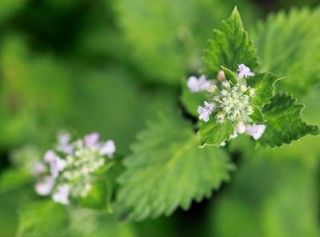How to grow catnip: The complete guide

Known for its ability to trigger a “high” in cats, catnip has been attracting cats for more than two documented centuries. What many don’t know though, is catnip can also be used in the kitchen and medicinally for humans making it a great herb to add to your indoor herb garden.
What is Catnip?
Also called catmint, catnip (Nepeta cataria) is a hardy perennial herb that is a member of the mint family. It is native to the area known as Eurasia: southern and eastern Europe, the Middle East, Central Asia, and parts of China.
Fairly easy to grow, It is now widely naturalized in northern Europe, New Zealand, and North America. Catnip grows outdoors in USDA growing hardiness zones 3 to 9 and makes great container plants for growing indoors, allowing you to extend its growing season to year-round.
Uses for Catnip
With uses for both cats and humans, there are many reasons to add catnip plants to your indoor herb garden.
The active compound in catnip is the essential oil nepetalactone. In cats nepetalactone is thought to mimic a feline pheromone, triggering brain receptors and the associated euphoric side effects.
In humans, catnip has many medicinal uses although it doesn’t induce the same euphoric response.

The enthusiast's guide to herbs
We’re proud to present our new e-book, The Enthusiast’s Guide to Herbs! Learn everything you need to know about growing and caring for herbs indoors, including in-depth info cards for the 35 most commonly grown herbs.
Click the link below to find out more!

Cats
Catnip can be used in a couple of different ways for cats. If catnip is eaten, it will act as a sedative for your cat; if it is sniffed it acts as a stimulant. In either case, it is completely safe and non-addictive.
Both the fresh foliage and the dried leaves and flowers are useful as a training tool or they can help to enrich, or exercise, indoor cats.
When cats sniff catnip plants, it triggers a euphoric effect that lasts anywhere from 5 to 15 minutes. When the euphoria wears off they are resistant to experiencing effects for the following 30 minutes.
To use as a training tool take fresh or dried catnip and rub it on an item you want your cat to direct his attention toward. For instance, if he is scratching and tearing up furniture, rub catnip on a scratching post to encourage him to scratch it instead. Or rub it on a spot you want your cat to sleep in or on.
With only a sniff or two of either dried catnip or fresh catnip, your cat may become more kitten-like in her behavior or overly affectionate towards you. She may also increase vocalization and roll, paw, or rub her face in the catnip source. Some cats may jump about excitedly, becoming frisky or run from room to room chasing what appears to be invisible prey.
There are a couple of situations you should avoid:
- Don’t give it to aggressive cats as it can exacerbate behavior.
- Give it in small amounts, too much can make your kitty cranky or nauseous.
- Avoid giving it to young cats or senior cats. It is believed that cats younger than 6 months have not matured sexually, and won’t see any effects.
Humans
Unlike our favorite felines, humans don’t see the same euphoric effect from catnip. Instead, we experience a calming, sedative response.
The medicinal uses of catnip include treating headaches, curbing nausea, inducing menstruation, and helping with anxiety or sleep disturbances/disorders. Two teaspoons of dried leaves and flowers can be steeped in one cup of boiling water to make a tea, and then consumed.
Catnip is sometimes even used as an insect repellent because of its strong aroma and is even used by some as an addition to food and teas.
What to avoid:
- Don’t consume if you are pregnant as it causes uterine contractions.
- Avoid if you are scheduled for surgery within a couple of weeks as it may alter how you react to anesthesia.

How to grow in containers
As a member of the mint family, catnip is also known for its aggressive growth and ability to quickly take over a garden or growing space. Growing it in containers is a great way to keep this aggressive growth under control.
Plants can either be started from seed or from stem cuttings taken off another plant.
From seed
When growing catnip indoors it’s best to sow seeds in the spring or the fall. Catnip seeds can be purchased online, at some local nurseries or garden centers, or may even be available from pet stores. Or if you know someone with plants you can ask them for some seeds off of their catnip.
- Fill containers with pre-moistened growing media.
- Bury seeds ¼” deep.
- Keep growing media moist but not soggy. Seeds need water for germination but you don’t want damping off to occur.
Germination typically takes 7 to 10 days. After seeds germinate, allow them to grow until they develop 5 or 6 leaves; at that time thin plants to one per 8 to 12” container.
Propagating
Starting plants from stem cuttings saves you from purchasing seeds, but is only doable if you already have plants or know someone else with them.
- Fill your container with pre-moistened growing media.
- Take a 6-inch stem cutting and remove all of the leaves from the bottom 2 inches.
- Dip the stem’s cut end in rooting hormone.
- Carefully plant stem cuttings in containers.

Supplies for planting
Growing plants indoors is a fairly inexpensive endeavor, only requiring containers and growing media.
Containers
Wide shallow containers are the most accommodating for catnip because of its tendency to shoot out runners and grow everywhere. This provides plenty of space for the new shoots to pop up without constricting the roots. A wider container is also less likely to tip over if your kitty decides to lay amidst the plant.
Since catnip likes to have its soil dry out between waterings terra cotta pots are a good choice. Their porous nature means air moves easily through the walls of the pots to keep roots from being waterlogged.
Growing Media
Standard potting soil or coconut coir are your best two options for a growing medium. Both are lightweight and have good water holding capacity.
Basic plant care for catnip
Like other herbs, catnip is quite easy to grow and needs little care beyond watering and pruning when given the appropriate growing conditions.
Lighting
Catnip plants need full sun locations, preferring at least 6 hours of sun exposure every day but liking shade in the afternoon when grown outside in hot climates. When growing containers indoors set them on a sunny windowsill of a south or west-facing window.
Rotate containers every couple of days to prevent plants from bending towards the light, a phenomenon known as phototropism.[1]
Plants will become leggy if they do not get enough sunlight. Simple growing lights can be purchased online or at a local nursery to supplement indoor lighting conditions if necessary.
Water
Plants are drought resistant and prefer the soil dry to out slightly between waterings. Allow the top inch of potting soil to dry out before giving your plant water. Then saturate the container until water freely drains out the bottom.
Fertilizing
Like mint, and other herbs bearing essential oils, it is recommended to not fertilize your catnip. Fertilization encourages prolific vegetative growth and reduces the quality of the oils in the foliage and flowers.
Pruning
If your plants aren’t occasionally trimmed back they will become scraggly. Regular pruning encourages bushier plants.
After your catnip flowers, cut the plants back to 3 to 4 inches above the ground. Within a couple of weeks, it will grow back; this new growth will trigger a new flowering cycle.
To prevent insect or disease problems remove dead or dried leaves regularly.
Harvesting
Material from the plant can be harvested any time you’d like to provide a treat for your feline friends, but the oils are at their peak when the plant is flowering. Try to wait until your plant is at least 6-inches tall before harvesting, then use a clean pair of sharp scissors and snip off an entire stem at the surface of the growing media.
Conclusion
Growing your own catnip indoors provides you with a constant, fresh supply of leaves and flowers for your cat’s, or your own enjoyment. Plans are easy to grow and need little care other than plenty of sunlight and watering when the soil dries out.

Join our email club—get printable info cards free!
Sign up to receive our newsletter and get access to 10 printable plant info cards from our e-book for free. Also receive:
- $4 discount code for our Guide to Herbs e-book
- Semi-weekly plant inspiration & bite-size tips and tricks
Whippo, C. W., & Hangarter, R. P. (2006). Phototropism: Bending towards Enlightenment. The Plant Cell, 18(5), 1110-1119. doi:10.1105/tpc.105.039669 ↩︎
